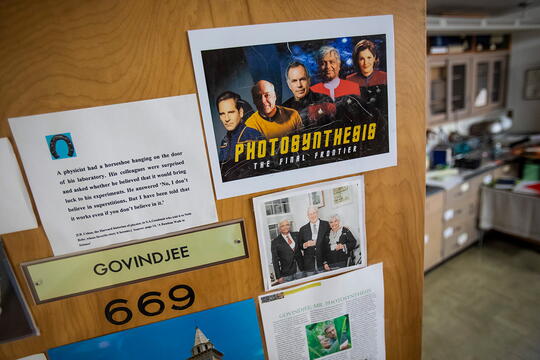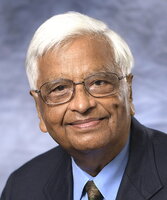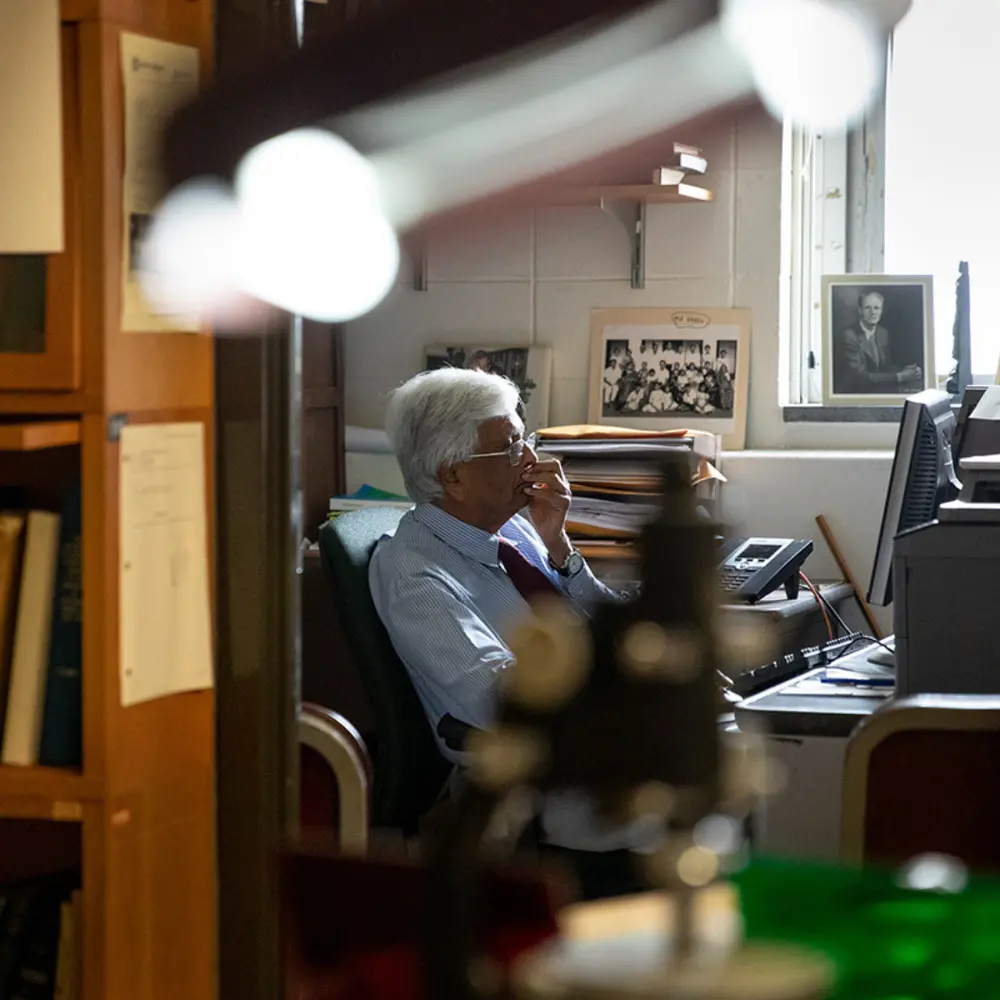
CHAMPAIGN, Ill. – I am in Govindjee’s office suite and I don’t know where to look. Govindjee, a professor emeritus of plant biology who goes by the one name only, is a collector. There are layers of history here: artifacts and papers, books and photographs. There also are homemade scientific instruments that look like plumbing elbows, tiny satellites or props from vintage sci-fi movies.
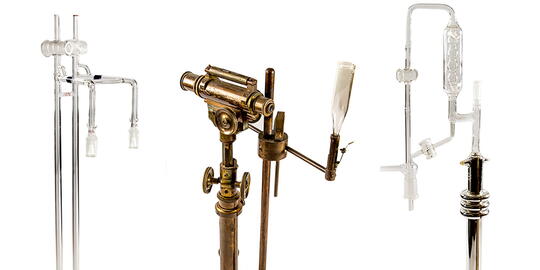
The collection engulfs two tiny offices and a more expansive shared space that connects them. It spills into the hallway and around the corner, where a glass-faced “cabinet of curiosities” is loaded with items that haven’t been used for decades but still retain an ageless, innovative luster.
Govindjee has each of these items catalogued in his memory, along with the names, dates and personalities of nearly every genius who ever tackled the puzzle of photosynthesis. Photos of many of those geniuses are on the walls, with scribbled notes like:
“Andy Benson, co-discoverer of Carbon Fixation Cycle. September 24, 1917 – Feb. 6, 2015. A dear friend.”
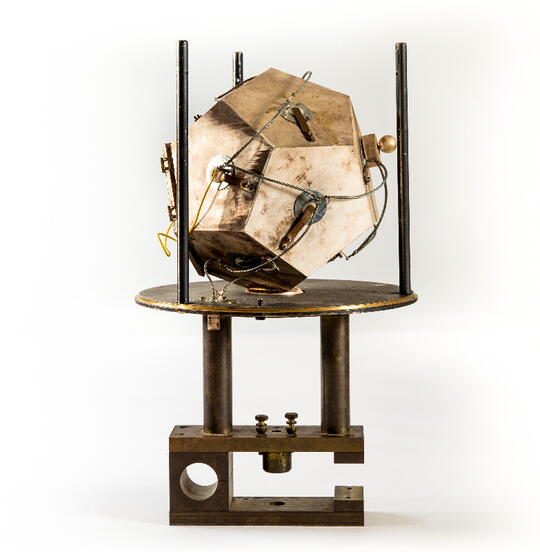
Govindjee guides me from one relic to another. Here is Robert Emerson's 1928 Ph.D. dissertation, written in German. Emerson was Govindjee’s mentor at the University of Illinois for two years – until an airplane crash took Emerson’s life in early 1959.
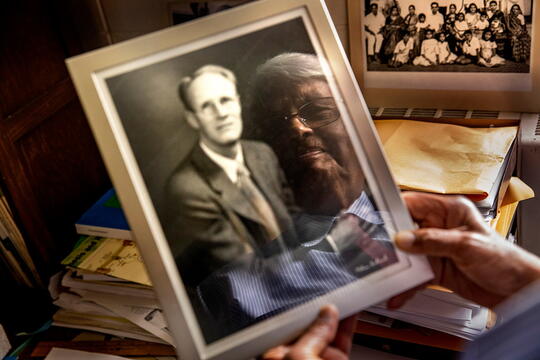
Here are the microscopes through which Govindjee and his colleagues looked at algae in the 1950s and 1960s. There is a yellowing logbook that lists the names of people – including a few Nobel laureates – who visited the photosynthesis lab over the years, with careful notations of what they were paid. In a corner hangs a framed illustration of 18th-century scientists who contributed key findings to understanding photosynthesis.
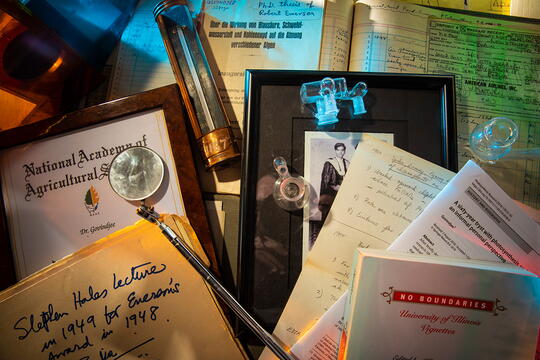
Many people don’t know it, but Illinois has been a leader in photosynthesis research for decades, a tradition that continues to this day. Govindjee is at the heart of a generation that made key discoveries about the complex and baffling process by which plants convert water, carbon dioxide and the discrete particles of light called photons into oxygen and the raw materials that make life possible on Earth.
“The most exciting thing for me was … I want to show you a picture,” Govindjee says, jumping up and stumbling over a chair on the way out of his tiny office. He leads me to to a giant, hand-painted poster – a diagram of photosynthesis – hanging on a door just outside the office. He made this chart in the early 1960s, and it still hangs in a place of prominence in this photosynthesis “museum.” It’s as big as he is.

“This is where my work is,” he says, pointing to one region on the chart. “We showed that bicarbonate is needed for electron and proton flow from one molecule to another. If you remove bicarbonate, then everything stops,” he says.
Bicarbonate is only one of the many molecular players in the complicated photochemical dance that makes photosynthesis possible. In the beginning, of course, none of these chemicals or mechanisms were known.
A few steps away from the poster are three dusty wooden boxes. Govindjee opens one to reveal a series of colored glass filters. In their early efforts to understand how photosynthetic organisms interact with light, he and other scientists exposed algae to different colors of filtered light and watched to see which wavelengths the algae absorbed and which they used for photosynthesis.
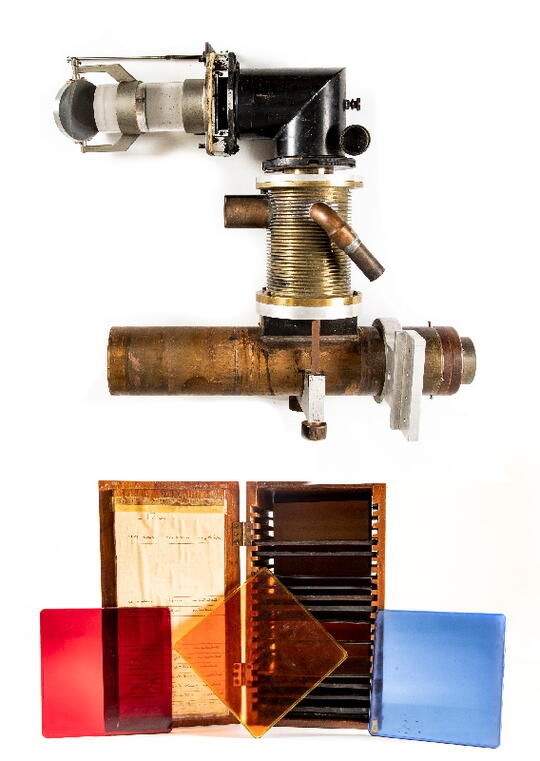
In the process, they discovered that algae and plants use several types of chlorophyll a, each with its own unique light preferences. Chlorophylls are the molecules that give most plant leaves their characteristic green color and do the work of converting sunlight to chemical energy, a process that generates oxygen as a byproduct.
Over time, the researchers pieced together much of the photosynthetic puzzle.
After Emerson’s death, Govindjee reinvestigated a scientific debate that had simmered between Emerson and Nobel laureate Otto Warburg. Each scientist had reported the number of photons needed for algae to produce a single molecule of oxygen. But their results differed – by a lot. Warburg said only four photons were needed per oxygen molecule; Emerson said it was 12. With painstaking care, Govindjee and his wife, Rajni Govindjee, who earned her Ph.D. at Illinois and also worked as a research scientist in photosynthesis, demonstrated that Emerson’s calculations were correct.
The Govindjees also found that chlorophyll a, one of several chlorophylls employed in photosynthesis, contributed to two light reactions that together drive photosynthesis.

In the early days, some researchers debated the existence of two reaction centers in plants driving the two light reactions. At a scientific conference in the early 1960s, a researcher from another institution scribbled on Govindjee’s poster that what is now universally accepted as a second reaction center in the photosynthetic pathway was nothing more than an “Illinois Fantasy.”

Over the course of more than 50 years of research, Govindjee has gotten to know, become friends with, or feuded with many scientific giants, and his work today also involves recounting their histories in relation to the history of photosynthesis. He is the author or editor of dozens of books on photosynthesis. He also has written or contributed to multiple historical reports.
At age 86, Govindjee still works as an educator and historian. He travels regularly around the world to lead educational sessions, speak at conferences and share his knowledge with other scientists, particularly in China and India. He remains engaged in promising research overseas. He writes about pivotal events in photosynthesis research. And he collects: letters, documents, posters, arguments and artifacts. They are all here somewhere, in this tiny shrine.

